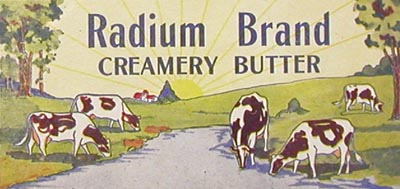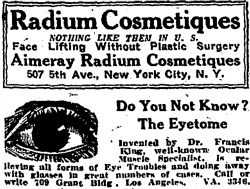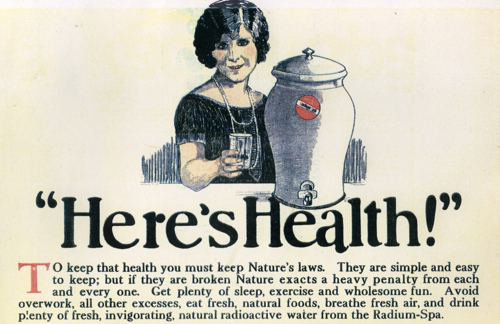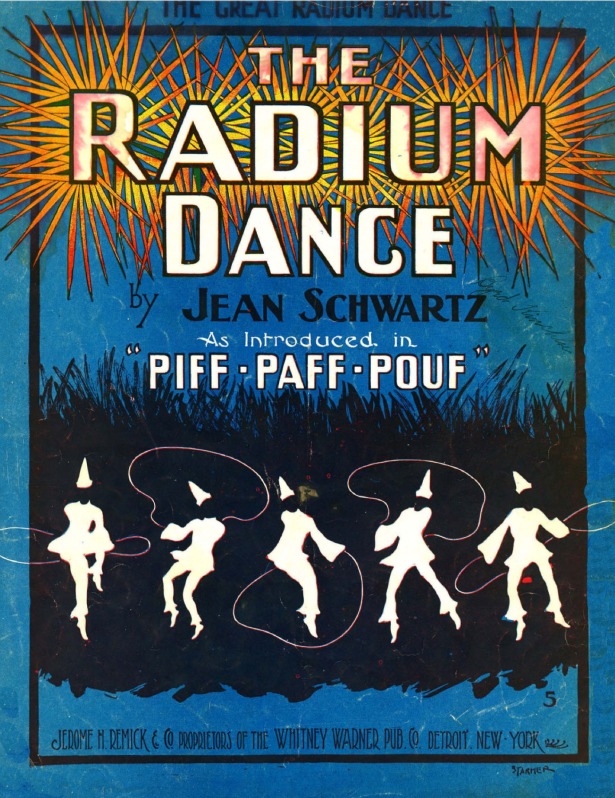How We Realized Putting Radium in Everything Was Not the Answer
Gone are the days when the only way to make butter seem even healthier was to name it after a radioactive element.

Beginning in the 1910s, the girls instructed to put radium in their mouths didn't bat an eyelash. They worked for the United States Radium Corporation painting the numbers and hands on watch faces and military instrument panels. Since the work required great detail, the women were told to "point" the small brush head with their lips, thus ingesting a small amount of radium every time. Each woman would repeat this hundreds of times a day. If there was any uneasiness with this process, the good money they got from the job alleviated it. The young women, many fresh out of high school, would playfully paint their nails and teeth with the luminous paint, known as UnDark. About ten years later, these "Radium Girls" would start to die.

It's no wonder the girls painting watch dials and such weren't aware of the dangers of straight up eating radium. In the first decades of the 20th century, America, along with the rest of the world, was enamored with it. The glowing element was hailed as a panacea for everything from blindness to hysteria. "No medicine, no drugs," raves one ad for an item claiming to help alleviate asthma and nine other things, "Just a light, small, comfortable, inexpensive Radio-Active Pad worn on the back by day and over the stomach at night." One particularly disturbing medical innovation was the "Radiendocrinator," a device the size of a thick stack of credit cards to be worn with an adaptor "like any 'athletic strap.'" Its inventor, who fervently claimed to use the product, later died of bladder cancer.
Radium was more than a medical cure-all. Adding radium to anything somehow made it better. The luminous metal was used in household products such as lipstick, chocolate (in Germany), tonics, and of course, watches. Radium was put into chicken feed with the hopes the eggs would self-incubate, or at least self-cook. Products that fraudulently touted radium as an ingredient were shut down by the government. But that didn't stop companies from riding the marketing wave it created.

Radium quickly became a veritable marketing force. Products that didn't have anything to do with radium carried the name of the expensive metal to add allure -- similar to the way we use words like "platinum" or "titanium" today. Numerous are the ads of this time for wares like "radium silk lingerie" and decks of cards with the word "radium" emblazoned on them. In one ad, a pastoral landscape dotted with grazing cows near a pristine stream are bathed in the warm glow of a rising sun. Above the sun are the words, "Radium Brand Creamery Butter." There was most likely no radium in said butter, but it must've been a boon to sales.
In 1925, a New York Times article ran the headline, "New Radium Disease Found; Has Killed 5." The new disease was called, "radium necrosis," a polite term for the painful process of one's jaw disintegrating and developing tumors. The five killed by this so-called "new radium disease" were a handful of the girls who were instructed to put radium in their mouths by way of paintbrush. "Trust in radium unjustified," the article sources from a New York doctor. "Cancer called incurable."

Researchers investigated the deaths for years, and a month after the inventor of UnDark succumbed to aplastic anemia from radium poisoning, little was done for the female radium painters. One factory owner suggested they start painting with a metal stylus instead of the brushes to stop getting sick.
Five of the women had filed lawsuit a year before and had come to be known as "the Radium Girls." After a very public trial, U.S. Radium settled and each of the five "Radium Girls" received $10,000 plus $600 every year they were alive, along with coverage for all hospital and legal expenses. They all died within a few short years. In the documentary Radium City, a story about the Radium Dial Company, an old man with a Geiger counter saunters over to the Catholic graveyard where many of the Radium Girls of the town were buried. As his Geiger counter confirms, their corpses are still radioactive.
The Radium Girls' lawsuit had tarnished the reputation of the magical miracle worker of radium. Gone were the days where the element was blindly celebrated, such as in the musical Piff, Paff, Pouf, where a song called The Radium Dance was a huge selling point. Luxury items such as "radium lingerie" began disappearing from newspaper advertisements. One particular item called Radithor -- a portmanteau of radium and mesothorium, an isotope of radium, was discontinued in 1928. Called, "Liquid Sunshine," its most famous consumer died 4 years later after losing most of his jaw, similar to the "occupational disease" the Radium Girls had. He was thought to have ingested at least 1400 bottles and was buried in a lead-lined coffin in Pittsburgh.
"Radium -- Boon or Menace?" was the title of a June 1932 article in Everyday Science and Mechanics. Its author interviewed 6 specialists and came up pretty much with the consensus we have today: radium can treat cancer pretty well sometimes. Sometimes it works the way you want, sometimes it doesn't, but in any case always make sure the radium is contained and please don't eat it.
The 1938 Food Drug and Cosmetic Act outlawed deceptive packaging that made Radithor and other radium-branded products marketable. Bye-bye Radium Brand Creamery Butter. Bye-bye radioactive jockstrap. Thanks to making deceptive packaging illegal, the law also banned a cosmetic called Lash Lure that was known to make women go blind, and Koremlu, a depilatory that contained chemicals known in rat poison that left countless paralyzed -- these aren't related to radium, I just think they're interesting.

Radium is still in household products today, but not deliberately and not in amounts considered harmful by the government. Brazil nuts and some granite counter tops contain radium. And -- if there was such a thing as Radithor's Revenge -- sometimes so does drinking water. As the EPA's site dedicated to radiation information, RadTown USA, informs us, "radiation is natural and all around us." And like the element itself, radium as a brand is still all around us, if only in trace amounts.
